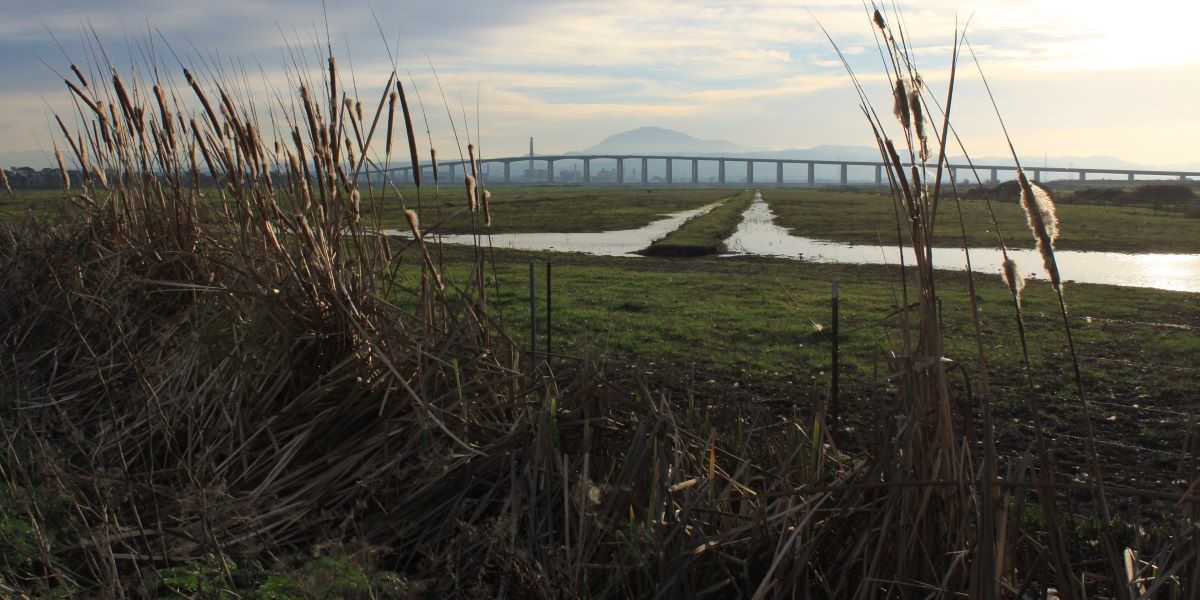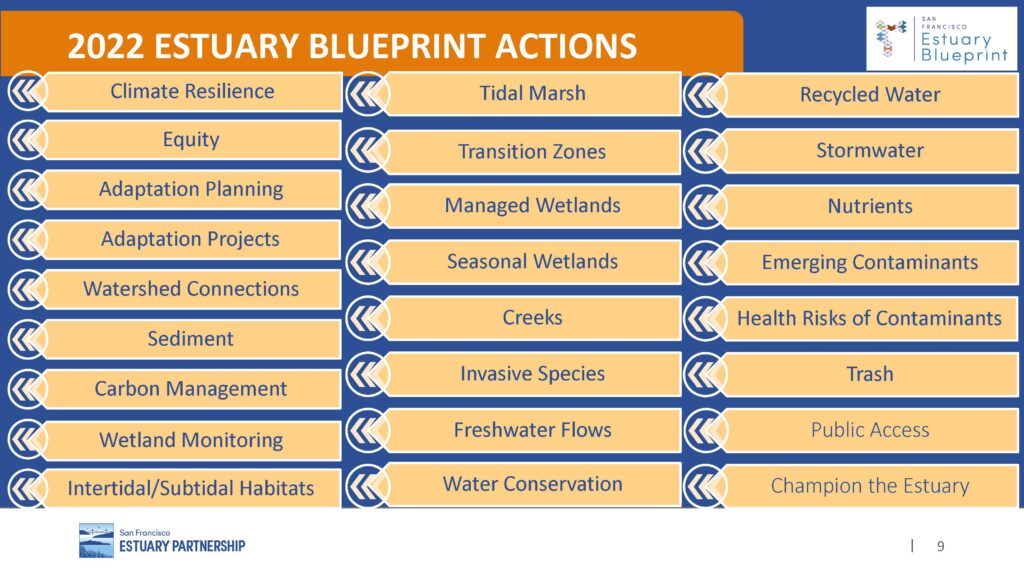The document is a collaborative five-year roadmap that outlines 25 actions to address chemical, physical, biological, and social-ecological processes in the San Francisco Estuary
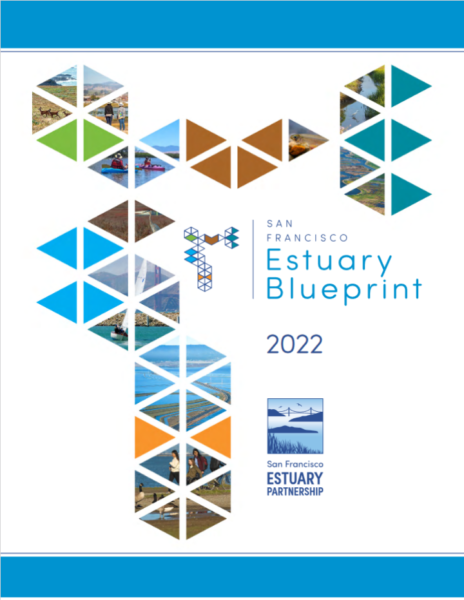 At the August meeting of the Delta Stewardship Council, Caitlin Sweeney, Executive Director of the San Francisco Estuary Partnership, provided an overview of the newly updated 2022-26 Estuary Blueprint.
At the August meeting of the Delta Stewardship Council, Caitlin Sweeney, Executive Director of the San Francisco Estuary Partnership, provided an overview of the newly updated 2022-26 Estuary Blueprint.
In introducing the agenda item, Amanda Bohl, Special Assistant for Planning and Science, read a passage from the preface to highlight the importance of the Estuary Blueprint: ‘As never before, the Estuary Blueprint emphasizes the connection between the lower and upper estuary. It recognizes that nature does not see the Bay and Delta as distinct but rather as a holistic, integrated system forming one beautiful estuary. With this in mind, the Bay and the Delta cannot adapt to climate change independently of one another. Agencies and organizations, state, federal, tribal, local, and non-governmental organizations must urgently mobilize our partnerships and collaborate to produce tangible results.’
Ms. Bohl acknowledged that working collaboratively across the Bay and the Delta has not always been practiced but is becoming more of the norm as scientists and planners work to identify common actions that need implementation. Joint objectives of the Delta Plan and Estuary Blueprint include climate resilience, equity, sediment, carbon management, and invasive species.
The San Francisco Estuary Partnership is a place-based non-regulatory program of the US Environmental Protection Agency and one of 28 estuaries in the National Estuary Program, which Congress established in the late 1980s to protect and restore estuaries of national significance. (Morro Bay and Santa Monica Bay are the other two California estuaries in the program.)
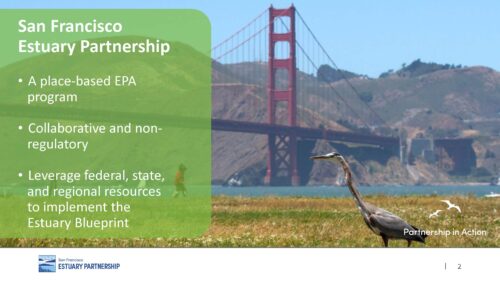 “In essence, we leverage funding and partnership to support efforts to protect, enhance, and restore the estuary system,” said Ms. Sweeney. “We work with a large suite of diverse partners with the Estuary blueprint as our guiding document.”
“In essence, we leverage funding and partnership to support efforts to protect, enhance, and restore the estuary system,” said Ms. Sweeney. “We work with a large suite of diverse partners with the Estuary blueprint as our guiding document.”
The Estuary Blueprint is a non-regulatory regional collaborative planning document required by the Clean Water Act. Technically it’s called a Comprehensive Conservation and Management Plan, or CCMP. In 1993, the first Estuary Blueprint was released. It was the first collaborative plan for the entire estuary developed by over 100 stakeholder groups, many of whom had really never sat down at the table together to agree on priorities. Since then, the plan has been updated several times and still serves as the most comprehensive plan for the ecological health of the entire estuary.
The 2022 update of the Estuary Blueprint document was released last month. It is both a regional vision for 2050 and an actionable strategy for what can be done over the next five years to get there. The Blueprint provides a roadmap for restoring the health of the estuary addressing its chemical, physical, biological, and social-ecological processes.
The estuary blueprint has four focus areas: resilience, living resources, water, and stewardship. However, the real work 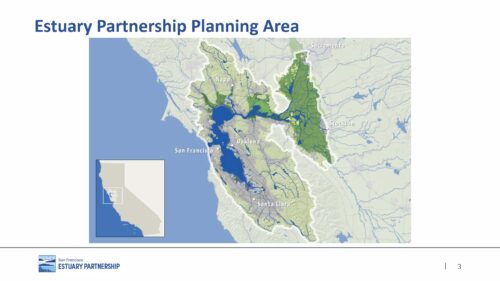 happens at the action level, so the Blueprint provides a mechanism for reaching an agreement among the myriad of partners on the highest priorities for the region and then documents those agreements in the form of fundable five-year actions to address those high priorities.
happens at the action level, so the Blueprint provides a mechanism for reaching an agreement among the myriad of partners on the highest priorities for the region and then documents those agreements in the form of fundable five-year actions to address those high priorities.
“The blueprint elevates those actions for support, whether that needed support is at the executive staff level, boards or commissions, the public, voters or elected officials, or potential funders,” said Ms. Sweeney.
This slide shows all 25 of the Estuary Blueprint actions in shorthand to illustrate the breadth of topics covered. Many of them are focused on climate resilience and adaptation, estuary-wide processes, habitat restoration, water quality and quantity, and human dimensions.
What does the Estuary Blueprint intend to do?
The Estuary Blueprint takes a comprehensive and collaborative approach to reach the shared regional vision. The 2022 update resulted from a two-year process with input from over 160 collaborating partner entities and hundreds of individuals, more participation than in any previous update.
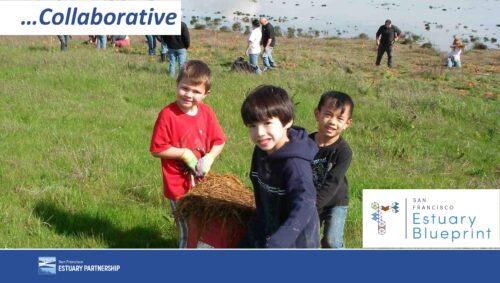 In advancing the goals of the Blueprint, they aim to break down silos by bringing diverse voices together and actively supporting new partnerships to address the most urgent challenges. The Blueprint identifies and elevates the highest priority actions needed now to ensure that all enjoy a thriving, resilient estuary into the future. The Blueprint strives to take an integrated approach, coordinating across geographies and systems, plans, and topic areas.
In advancing the goals of the Blueprint, they aim to break down silos by bringing diverse voices together and actively supporting new partnerships to address the most urgent challenges. The Blueprint identifies and elevates the highest priority actions needed now to ensure that all enjoy a thriving, resilient estuary into the future. The Blueprint strives to take an integrated approach, coordinating across geographies and systems, plans, and topic areas.
“On a localized scale, the Blueprint advances integration across landscapes, connecting our uplands with our wetlands, our tributaries with our floodplains, seeking to restore complete ecosystems and supporting the science needed to do that,” said Ms. Sweeney. “Then, more broadly, the group really looks at the Bay and Delta as one interconnected ecological system, acknowledging that the decisions we make in one area that estuary absolutely impacts other areas. And when we try to manage the system as two distinct and separate areas, we certainly face the consequences.”
The Blueprint supports and advances other planning efforts throughout the region, highlighting the highest priority, cross-jurisdictional, and cross-system issues with the health of the estuary as the common foundation.
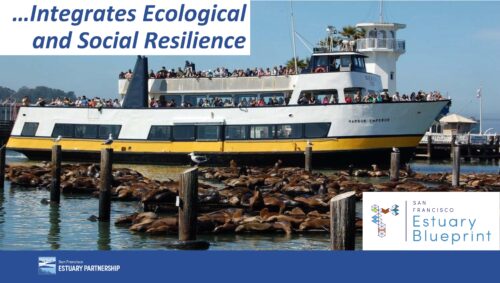 She said the relationship between the estuary and the people who live, work, and play along it is reciprocal. “Many of the same drivers that put the health and function of the estuary so at risk have also placed certain communities at risk and have resulted in disproportionate impacts to vulnerable, underserved, and marginalized communities. And the benefits of our work to protect, restore and enhance the estuary are not distributed or accessed equitably. And we’re missing many voices at the tables at which these decisions are made.”
She said the relationship between the estuary and the people who live, work, and play along it is reciprocal. “Many of the same drivers that put the health and function of the estuary so at risk have also placed certain communities at risk and have resulted in disproportionate impacts to vulnerable, underserved, and marginalized communities. And the benefits of our work to protect, restore and enhance the estuary are not distributed or accessed equitably. And we’re missing many voices at the tables at which these decisions are made.”
“So the 2022 Blueprint weaves tasks addressing equity considerations throughout the document under various topics, as well as including a new action focus specifically on supporting the critical roles that indigenous and frontline communities play in promoting estuary health and resilience. I’d say in this arena, we still have a long way to go. But I’m very encouraged by how the 2022 Blueprint goes further than previous versions to really elevate equity to a priority concern.”
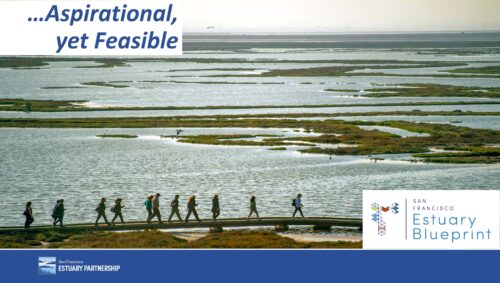 The Blueprint walks the line between aspirational yet feasible. “Every time we update the Blueprint, we have an opportunity to push ourselves in our region to do more, be more innovative, be more responsive and ambitious, and push for expanded partnerships and more collaboration,” said Ms. Sweeney. “And yet, we also don’t want to reach so high that we accomplish nothing. So I think of it this way: If we had all the funding we needed, all the capacity required, and all the partnerships in place, we should be able to implement all of the actions in the Blueprint within its five-year timeframe. So it’s aspirational yet feasible.”
The Blueprint walks the line between aspirational yet feasible. “Every time we update the Blueprint, we have an opportunity to push ourselves in our region to do more, be more innovative, be more responsive and ambitious, and push for expanded partnerships and more collaboration,” said Ms. Sweeney. “And yet, we also don’t want to reach so high that we accomplish nothing. So I think of it this way: If we had all the funding we needed, all the capacity required, and all the partnerships in place, we should be able to implement all of the actions in the Blueprint within its five-year timeframe. So it’s aspirational yet feasible.”
The San Francisco Estuary Partnership and the Estuary Blueprint serve a coordinating function to bring together a diversity of stakeholders to achieve common goals. The Blueprint is non-regulatory, meaning that agencies are not required to abide by it, but it is also actionable and measurable.
“There are milestones identified and 100 different organizations listed as lead partners and collaborators so that we have a real shared ownership of the blueprint, a shared investment in its implementation, and shared accountability,” said Ms. Sweeney. “We have an elaborate tracking system to measure progress, we have a feedback system to track changes in environmental health through the State of the Estuary report, and we have a variety of forums to share both quantitative and qualitative results, calling attention to the challenges that we still face, but also celebrating our successes along the way.”
Integration with the Delta Plan
During the development of the Estuary Blueprint, Ms. Sweeney said they worked with Delta Stewardship Council staff to crosswalk the blueprint goals, actions, and tasks with the Delta Plan, the Science Action Agenda, and Delta Adapts to identify those common priorities and to leverage each other’s areas of expertise and to focus and align efforts wherever possible.
“The Delta Stewardship Council is listed as the lead for 12 tasks and an implementing partner on 20 additional tasks, covering climate resilience and adaptation, equity, carbon management, habitat restoration, monitoring, invasive species, nutrients, and more,” she said. “We’re continuing to collaborate with Stewardship Council staff as we transition to implementation and tracking our progress.”
Next steps
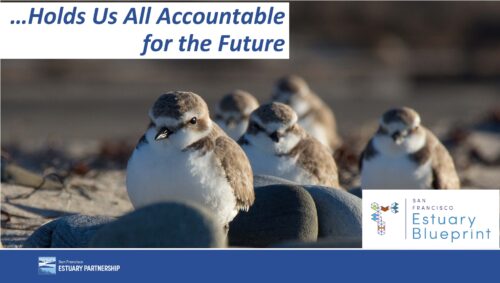 As for the next steps, the Estuary Partnership is beginning to track the progress of the partnerships carrying out the 126 tasks under the 25 actions. A new website offers various ways to engage with the Blueprint, including downloading the fully formatted document for viewing or printing and exploring the Blueprint through a story maps tour. The story map includes an interview with Delta Lead Scientist Laura Larsen which underscores the importance of viewing the estuary as a connected ecological system.
As for the next steps, the Estuary Partnership is beginning to track the progress of the partnerships carrying out the 126 tasks under the 25 actions. A new website offers various ways to engage with the Blueprint, including downloading the fully formatted document for viewing or printing and exploring the Blueprint through a story maps tour. The story map includes an interview with Delta Lead Scientist Laura Larsen which underscores the importance of viewing the estuary as a connected ecological system.
The website has a robust action and progress section, with each action on a separate page that includes a description, the lead and collaborating partners, a rough cost estimate for completion, and a gauge to track each task’s progress or completion level. The gauges are all currently set at zero, but that will change once they start tracking progress. It will be updated on a quarterly basis.
In conclusion …
“I’m very excited about having a timely and relevant Estuary Blueprint aligned with other critical planning efforts throughout the regions so that we can move towards a coordinated approach to accessing and spending money strategically, efficiently, and effectively where possible,” Ms. Sweeney said. “We’ve got a great influx of federal and state funding coming to our region for us to do wonderful things with. It’s a great time. So I look forward to continuing to work with the Delta Stewardship Council on project and program support development, funding, and implementation.”
Click here to learn more about the Estuary Blueprint and to view/download the report.


